Multi-Scenario Simulation of Land-Use Change and Delineation of Urban Growth Boundaries in County Area: A Case Study of Xinxing County, Guangdong Province
Abstract
1. Introduction
2. Study Area and Data
2.1. Study Area
2.2. Data Sources and Pre-Processing
3. Methodology
3.1. Land-Use Demand Projection
3.1.1. Markov Chain Model
3.1.2. SD Model
3.2. Future LULC Change Simulation
3.3. Delineating UGBs by Morphological Method
4. Results
4.1. Model Validation
4.2. Analyzing the Underlying Driving Forces of the LULC Change
4.3. Multi-Scenario LULC Simulation
4.4. Multi-Scenario LULC Simulation
4.4.1. Future LULC Demand Projection
4.4.2. Future LULC Distribution Simulation
4.4.3. UGBs Delineation
5. Discussion
5.1. Delineating UGBs with and without “Three-Line Coordination”
5.2. Urban Planning Suggestion
5.3. Limitations and Future Research Prospects
6. Conclusions
Author Contributions
Funding
Data Availability Statement
Conflicts of Interest
References
- Zhang, D.; Liu, X.; Lin, Z.; Zhang, X.; Zhang, H. The delineation of urban growth boundaries in complex ecological environment areas by using cellular automata and a dual-environmental evaluation. J. Clean. Prod. 2020, 256, 120361. [Google Scholar] [CrossRef]
- Grimm, N.B.; Faeth, S.H.; Golubiewski, N.E.; Redman, C.L.; Wu, J.; Bai, X.; Briggs, J.M. Global Change and the Ecology of Cities. Am. Assoc. Adv. Sci. 2008, 319, 756–760. [Google Scholar] [CrossRef]
- Chigbu, U.E.; Schopf, A.; de Vries, W.T.; Masum, F.; Mabikke, S.; Antonio, D.; Espinoza, J. Combining land-use planning and tenure security: A tenure responsive land-use planning approach for developing countries. J. Environ. Plan. Manag. 2017, 60, 1622–1639. [Google Scholar] [CrossRef]
- Wang, L.; Pijanowski, B.; Yang, W.; Zhai, R.; Omrani, H.; Li, K. Predicting multiple land use transitions under rapid urbanization and implications for land management and urban planning: The case of Zhanggong District in central China. Habitat Int. 2018, 82, 48–61. [Google Scholar] [CrossRef]
- Cui, X.; Li, S.; Gao, F. Examining spatial carbon metabolism: Features, future simulation, and land-based mitigation. Ecol. Model. 2020, 438, 109325. [Google Scholar] [CrossRef]
- Zhou, Y.; Huang, X.; Chen, Y.; Zhong, T.; Xu, G.; He, J.; Xu, Y.; Meng, H. The effect of land use planning (2006–2020) on construction land growth in China. Cities 2017, 68, 37–47. [Google Scholar] [CrossRef]
- Wang, L.; Han, H.; Lai, S. Do plans contain urban sprawl? A comparison of Beijing and Taipei. Habitat Int. 2014, 42, 121–130. [Google Scholar] [CrossRef]
- Bidandi, F.; Williams, J.J. Understanding urban land, politics, and planning: A critical appraisal of Kampala’s urban sprawl. Cities 2020, 106, 102858. [Google Scholar] [CrossRef]
- Lei, Y.; Flacke, J.; Schwarz, N. Does Urban planning affect urban growth pattern? A case study of Shenzhen, China. Land Use Policy 2021, 101, 105100. [Google Scholar] [CrossRef]
- Ball, M.; Cigdem, M.; Taylor, E.; Wood, G. Urban Growth Boundaries and their Impact on Land Prices. Environ. Plan. A Econ. Space 2014, 46, 3010–3026. [Google Scholar] [CrossRef]
- Tayyebi, A.; Perry, P.C.; Tayyebi, A.H. Predicting the expansion of an urban boundary using spatial logistic regression and hybrid raster-vector routines with remote sensing and GIS. Int. J. Geogr. Inf. Sci. IJGIS 2014, 28, 639–659. [Google Scholar] [CrossRef]
- Mathur, S. Impact of an urban growth boundary across the entire house price spectrum: The two-stage quantile spatial regression approach. Land Use Policy 2019, 80, 88–94. [Google Scholar] [CrossRef]
- Gallent, N.; Bianconi, M.; Andersson, J. Planning on the Edge: England’s Rural—Urban Fringe and the Spatial-Planning Agenda. Environ. Plan. B Plan. Des. 2006, 33, 457–476. [Google Scholar] [CrossRef]
- Jun, M. The Effects of Portland’s Urban Growth Boundary on Urban Development Patterns and Commuting. Urban Stud. 2004, 41, 1333–1348. [Google Scholar] [CrossRef]
- Moffett, K.B.; Makido, Y.; Shandas, V. Urban-Rural Surface Temperature Deviation and Intra-Urban Variations Contained by an Urban Growth Boundary. Remote Sens. 2019, 11, 2683. [Google Scholar] [CrossRef]
- Liang, X.; Liu, X.; Li, X.; Chen, Y.; Tian, H.; Yao, Y. Delineating multi-scenario urban growth boundaries with a CA-based FLUS model and morphological method. Landsc. Urban Plan. 2018, 177, 47–63. [Google Scholar] [CrossRef]
- Wu, X.; Liu, X.; Liang, X.; Chen, G. Multi-scenarios simulation of urban growth boundaries in Pearl River Delta based on FLUS-UGB. J. Geo-Inf. Sci. 2018, 20, 532–542. [Google Scholar]
- Ma, S.; Li, X.; Cai, Y. Delimiting the urban growth boundaries with a modified ant colony optimization model. Comput. Environ. Urban Syst. 2017, 62, 146–155. [Google Scholar] [CrossRef]
- Cerreta, M.; De Toro, P. Urbanization suitability maps: A dynamic spatial decision support system for sustainable land use. Earth Syst. Dyn. 2012, 3, 157–171. [Google Scholar] [CrossRef]
- Bhatta, B. Modelling of urban growth boundary using geoinformatics. Int. J. Digit. Earth 2009, 2, 359–381. [Google Scholar] [CrossRef]
- Cao, K.; Huang, B.; Wang, S.; Lin, H. Sustainable land use optimization using Boundary-based Fast Genetic Algorithm. Comput. Environ. Urban Syst. 2012, 36, 257–269. [Google Scholar] [CrossRef]
- Li, X.; Chen, G.; Liu, X.; Liang, X.; Wang, S.; Chen, Y.; Pei, F.; Xu, X. A New Global Land-Use and Land-Cover Change Product at a 1-km Resolution for 2010 to 2100 Based on Human-Environment Interactions. Ann. Am. Assoc. Geogr. 2017, 107, 1040–1059. [Google Scholar] [CrossRef]
- Zhang, D.; Liu, X.; Wu, X.; Yao, Y.; Wu, X.; Chen, Y. Multiple intra-urban land use simulations and driving factors analysis: A case study in Huicheng, China. GISci. Remote Sens. 2019, 56, 282–308. [Google Scholar] [CrossRef]
- Yang, X.; Bai, Y.; Che, L.; Qiao, F.; Xie, L. Incorporating ecological constraints into urban growth boundaries: A case study of ecologically fragile areas in the Upper Yellow River. Ecol. Indic. 2021, 124, 107436. [Google Scholar] [CrossRef]
- Yang, X.; Chen, R.; Zheng, X.Q. Simulating land use change by integrating ANN-CA model and landscape pattern indices. Geomat. Nat. Hazards Risk 2016, 7, 918–932. [Google Scholar] [CrossRef]
- Verburg, P.H.; Soepboer, W.; Veldkamp, A.; Limpiada, R.; Espaldon, V.; Mastura, S.S.A. Modeling the Spatial Dynamics of Regional Land Use: The CLUE-S Model. Environ. Manag. 2002, 30, 391–405. [Google Scholar] [CrossRef]
- Chen, Y.; Li, X.; Liu, X.; Ai, B. Modeling urban land-use dynamics in a fast developing city using the modified logistic cellular automaton with a patch-based simulation strategy. Int. J. Geogr. Inf. Sci. IJGIS 2014, 28, 234–255. [Google Scholar] [CrossRef]
- Liu, X.; Liang, X.; Li, X.; Xu, X.; Ou, J.; Chen, Y.; Li, S.; Wang, S.; Pei, F. A future land use simulation model (FLUS) for simulating multiple land use scenarios by coupling human and natural effects. Landsc. Urban Plan. 2017, 168, 94–116. [Google Scholar] [CrossRef]
- Liu, X.; Wei, M.; Li, Z.; Zeng, J. Multi-scenario simulation of urban growth boundaries with an ESP-FLUS model: A case study of the Min Delta region, China. Ecol. Indic. 2022, 135, 108538. [Google Scholar] [CrossRef]
- Liang, X.; Guan, Q.; Clarke, K.C.; Liu, S.; Wang, B.; Yao, Y. Understanding the drivers of sustainable land expansion using a patch-generating land use simulation (PLUS) model: A case study in Wuhan, China. Comput. Environ. Urban Syst. 2021, 85, 101569. [Google Scholar] [CrossRef]
- Li, C.; Wu, Y.; Gao, B.; Zheng, K.; Wu, Y.; Li, C. Multi-scenario simulation of ecosystem service value for optimization of land use in the Sichuan-Yunnan ecological barrier, China. Ecol. Indic. 2021, 132, 108328. [Google Scholar] [CrossRef]
- Gao, L.; Tao, F.; Liu, R.; Wang, Z.; Leng, H.; Zhou, T. Multi-scenario simulation and ecological risk analysis of land use based on the PLUS model: A case study of Nanjing. Sustain. Cities Soc. 2022, 85, 104055. [Google Scholar] [CrossRef]
- Wang, Z.; Li, X.; Mao, Y.; Li, L.; Wang, X.; Lin, Q. Dynamic simulation of land use change and assessment of carbon storage based on climate change scenarios at the city level: A case study of Bortala, China. Ecol. Indic. 2022, 134, 108499. [Google Scholar] [CrossRef]
- Tian, L.; Tao, Y.; Fu, W.; Li, T.; Ren, F.; Li, M. Dynamic Simulation of Land Use/Cover Change and Assessment of Forest Ecosystem Carbon Storage under Climate Change Scenarios in Guangdong Province, China. Remote Sens. 2022, 14, 2330. [Google Scholar] [CrossRef]
- Chen, Y.; Wang, J.; Xiong, N.; Sun, L.; Xu, J. Impacts of Land Use Changes on Net Primary Productivity in Urban Agglomerations under Multi-Scenarios Simulation. Remote Sens. 2022, 14, 1755. [Google Scholar] [CrossRef]
- Chen, C.; Liu, Y. Spatiotemporal changes of ecosystem services value by incorporating planning policies: A case of the Pearl River Delta, China. Ecol. Model. 2021, 461, 109777. [Google Scholar] [CrossRef]
- Wang, X.; Yao, Y.; Ren, S.; Shi, X. A coupled FLUS and Markov approach to simulate the spatial pattern of land use in rapidly developing cities. J. Geo-Inf. Sci. 2022, 24, 100–113. [Google Scholar]
- Li, S.; Liu, X.; Li, X.; Chen, Y. Simulation model of land use dynamics and application: Progress and prospects. J. Remote Sens. 2017, 21, 329–340. [Google Scholar]
- Huang, Z.; Li, S.; Gao, F.; Wang, F.; Lin, J.; Tan, Z. Evaluating the performance of LBSM data to estimate the gross domestic product of China at multiple scales: A comparison with NPP-VIIRS nighttime light data. J. Clean. Prod. 2021, 328, 129558. [Google Scholar] [CrossRef]
- Chen, X.; Nordhaus, W.D. VIIRS Nighttime Lights in the Estimation of Cross-Sectional and Time-Series GDP. Remote Sens. 2019, 11, 1057. [Google Scholar] [CrossRef]
- Li, S.; Lyu, D.; Liu, X.; Tan, Z.; Gao, F.; Huang, G.; Wu, Z. The varying patterns of rail transit ridership and their relationships with fine-scale built environment factors: Big data analytics from Guangzhou. Cities 2020, 99, 102580. [Google Scholar] [CrossRef]
- Li, S.; Lyu, D.; Huang, G.; Zhang, X.; Gao, F.; Chen, Y.; Liu, X. Spatially varying impacts of built environment factors on rail transit ridership at station level: A case study in Guangzhou, China. J. Transp. Geogr. 2020, 82, 102631. [Google Scholar] [CrossRef]
- Yi, D.; Guo, X.; Han, Y.; Guo, J.; Ou, M.; Zhao, X. Coupling Ecological Security Pattern Establishment and Construction Land Expansion Simulation for Urban Growth Boundary Delineation: Framework and Application. Land 2022, 11, 359. [Google Scholar] [CrossRef]
- Wang, W.; Jiao, L.; Zhang, W.; Jia, Q.; Su, F.; Xu, G.; Ma, S. Delineating urban growth boundaries under multi-objective and constraints. Sustain. Cities Soc. 2020, 61, 102279. [Google Scholar] [CrossRef]
- Liu, Y.; Yan, B.; Wang, Y. Urban-Rural Development Problems and Transformation Countermeasures in the New Period in China. Econ. Geogr. 2016, 36, 1–8. [Google Scholar]
- Vimal, R.; Geniaux, G.; Pluvinet, P.; Napoleone, C.; Lepart, J. Detecting threatened biodiversity by urbanization at regional and local scales using an urban sprawl simulation approach: Application on the French Mediterranean region. Landsc. Urban Plan. 2012, 104, 343–355. [Google Scholar] [CrossRef]
- Shoemaker, D.A.; BenDor, T.K.; Meentemeyer, R.K. Anticipating trade-offs between urban patterns and ecosystem service production: Scenario analyses of sprawl alternatives for a rapidly urbanizing region. Comput. Environ. Urban Syst. 2019, 74, 114–125. [Google Scholar] [CrossRef]
- Dupras, J.; Marull, J.; Parcerisas, L.; Coll, F.; Tello, E. The impacts of urban sprawling on ecological patterns and processes in the Montreal Metropolitan Region (Quebec, Canada) between 1966 and 2010. Environ. Sci. Policy 2016, 58, 61–73. [Google Scholar] [CrossRef]
- Chen, Z.; Wang, F.; Li, S.; Feng, Y.; Chen, J. Classification of county leading function types and pattern recognition of Its spatial structure based on multi-source data. J. Geo-Inf. Sci. 2021, 23, 2215–2223. [Google Scholar]
- Han, G.; Zhao, K.; Yuan, X.; Sun, R. Evaluation of Ecological Sensitivity in Mountain Area Based on Spatial Analysis: A Case Study of Wanyuan City in Sichuan Province. J. Mt. Sci. 2008, 5, 531–537. [Google Scholar]
- Levin, N.; Duke, Y. High spatial resolution night-time light images for demographic and socio-economic studies. Remote Sens. Environ. 2012, 119, 1–10. [Google Scholar] [CrossRef]
- Cui, H.; Zhang, J.; Li, H.; Yao, F.; Huang, H.; Weiqing, M. Integration of Multinomial-Logistic and Markov-Chain Models to Derive Land-Use Change Dynamics. Am. Soc. Civ. Eng. 2014, 141, 05014017. [Google Scholar]
- Song, M.; Chen, D.; Woodstock, K.; Zhang, Z.; Wu, Y. An RP-MCE-SOP Framework for China’s County-Level “Three-Space” and “Three-Line” Planning—An Integration of Rational Planning, Multi-Criteria Evaluation, and Spatial Optimization. Sustainability 2019, 11, 2997. [Google Scholar] [CrossRef]
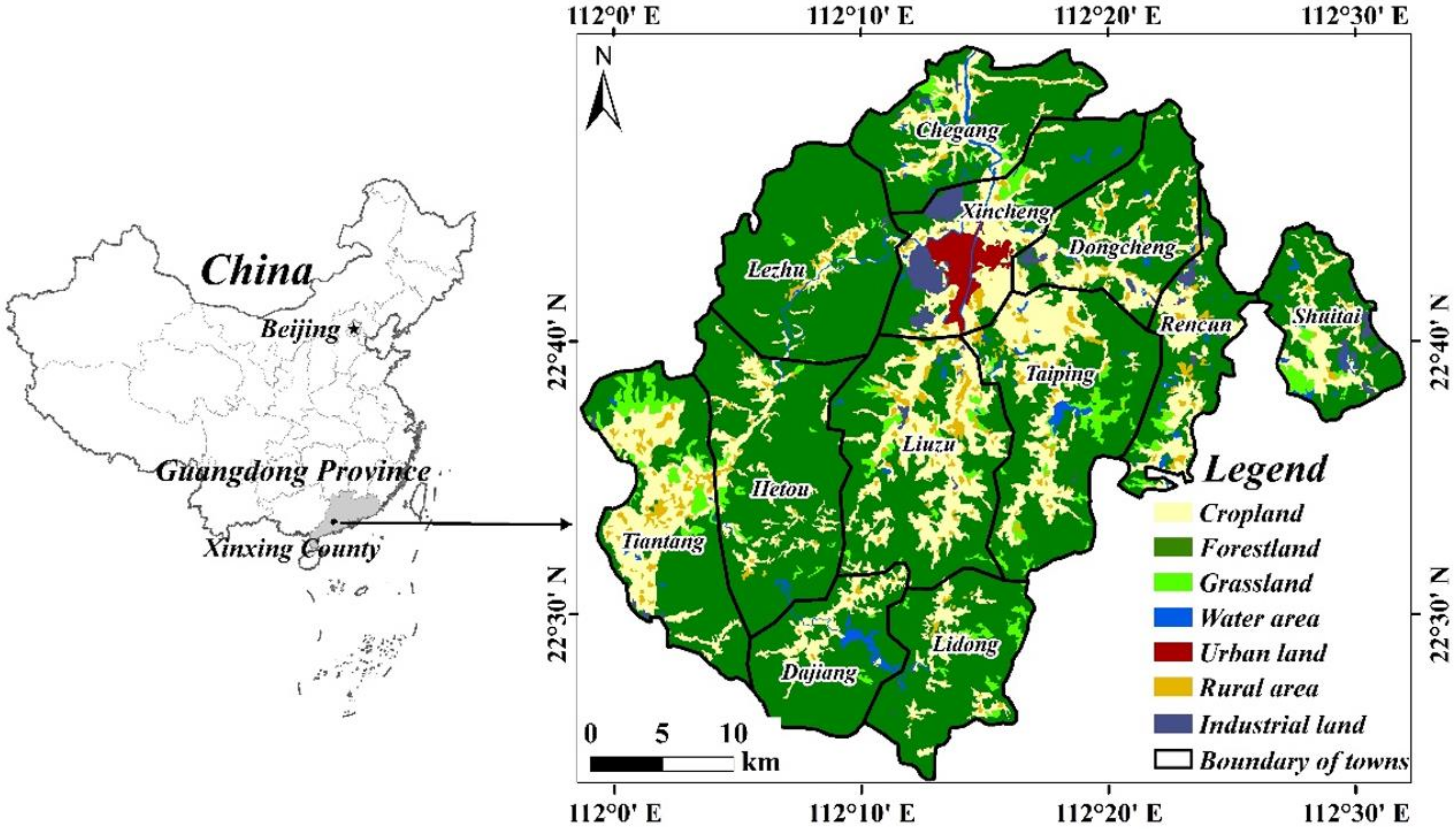

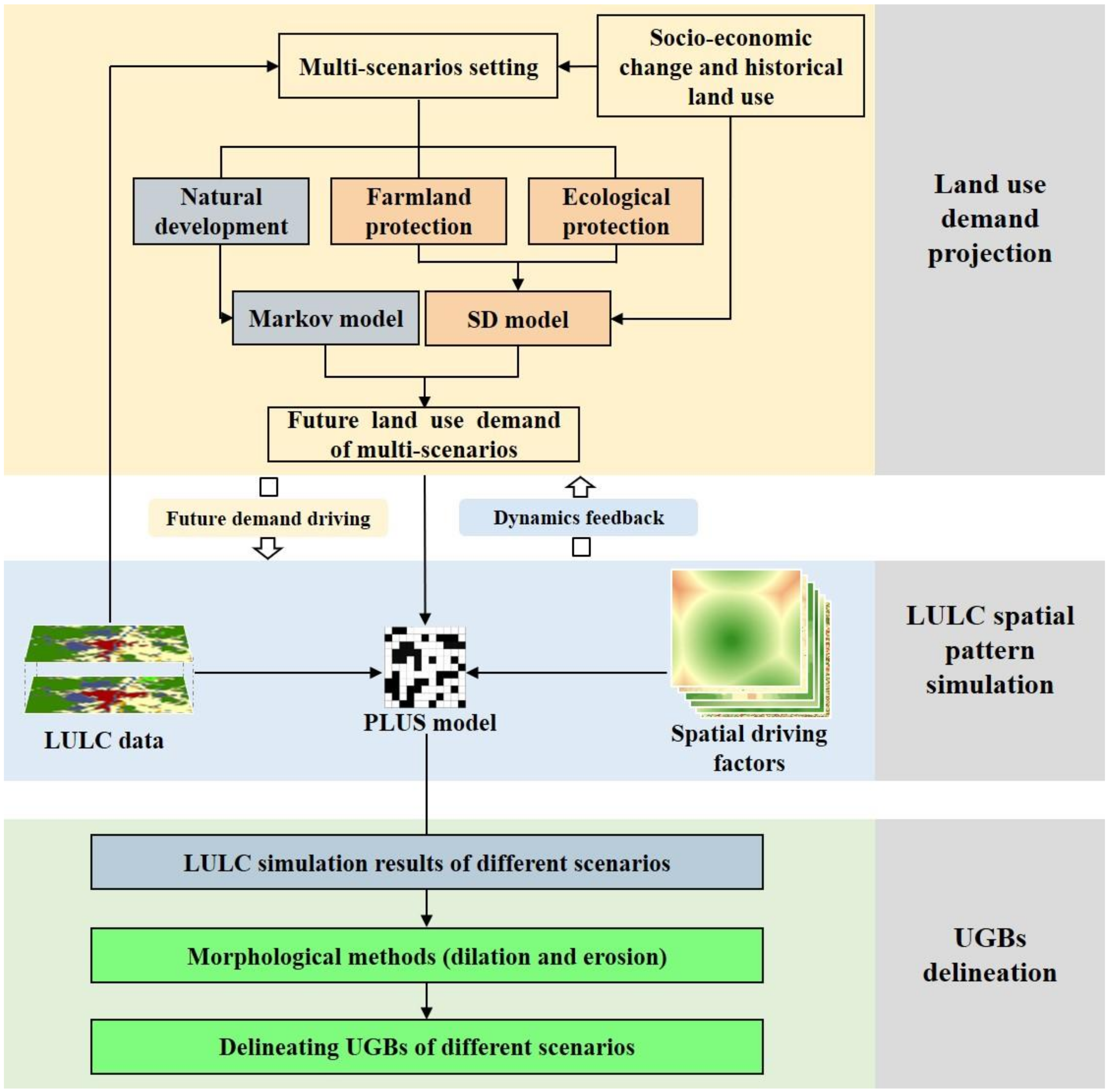
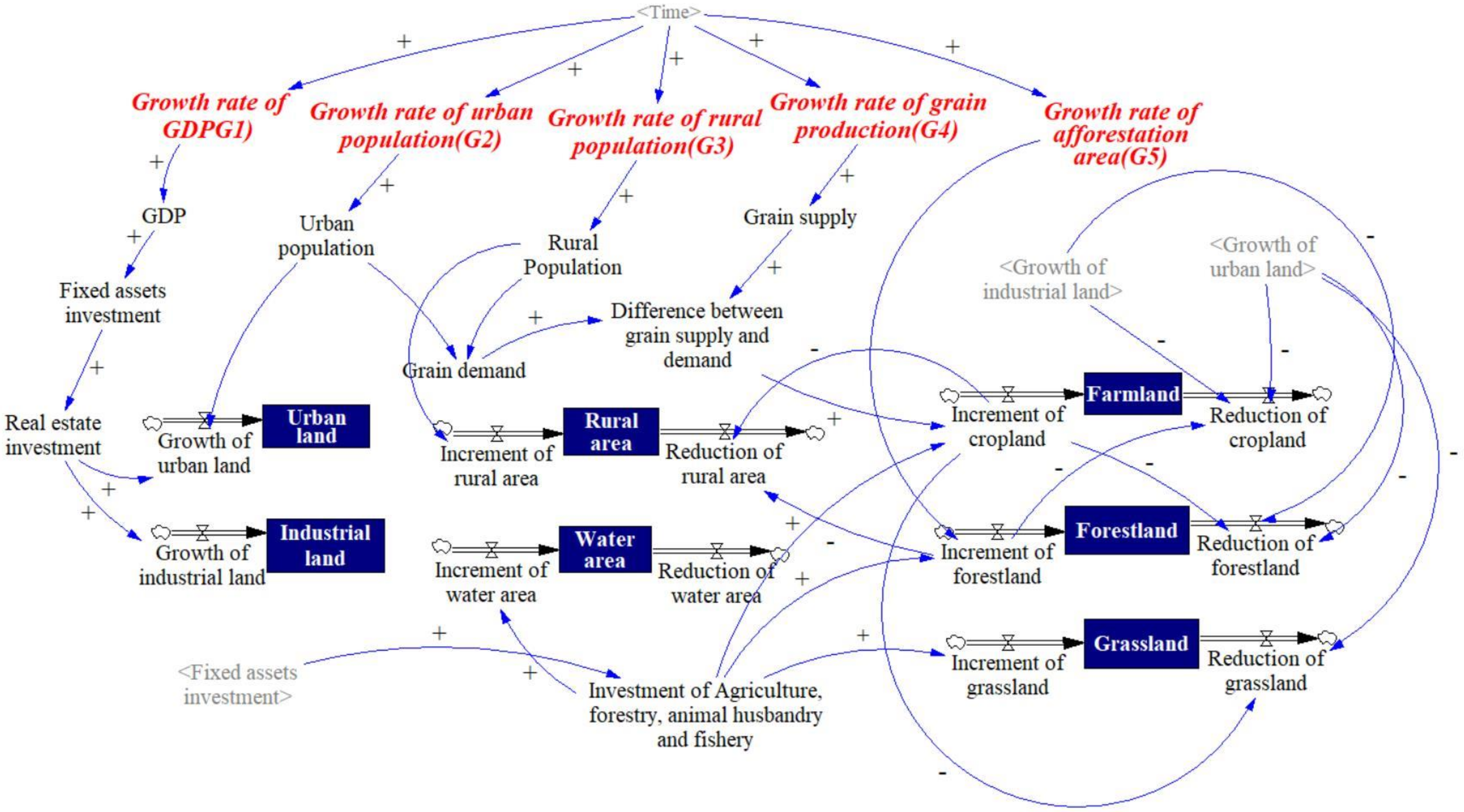



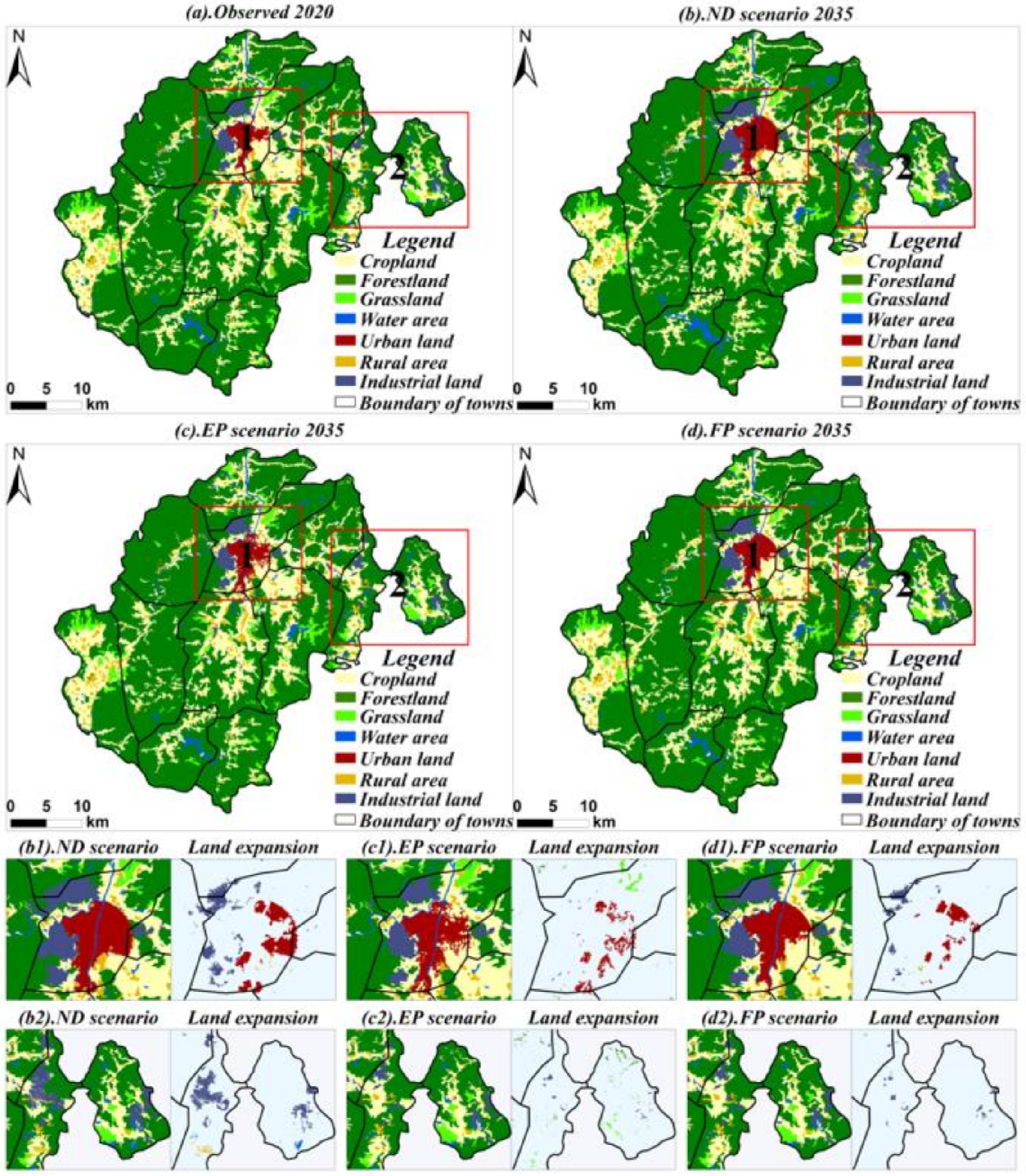
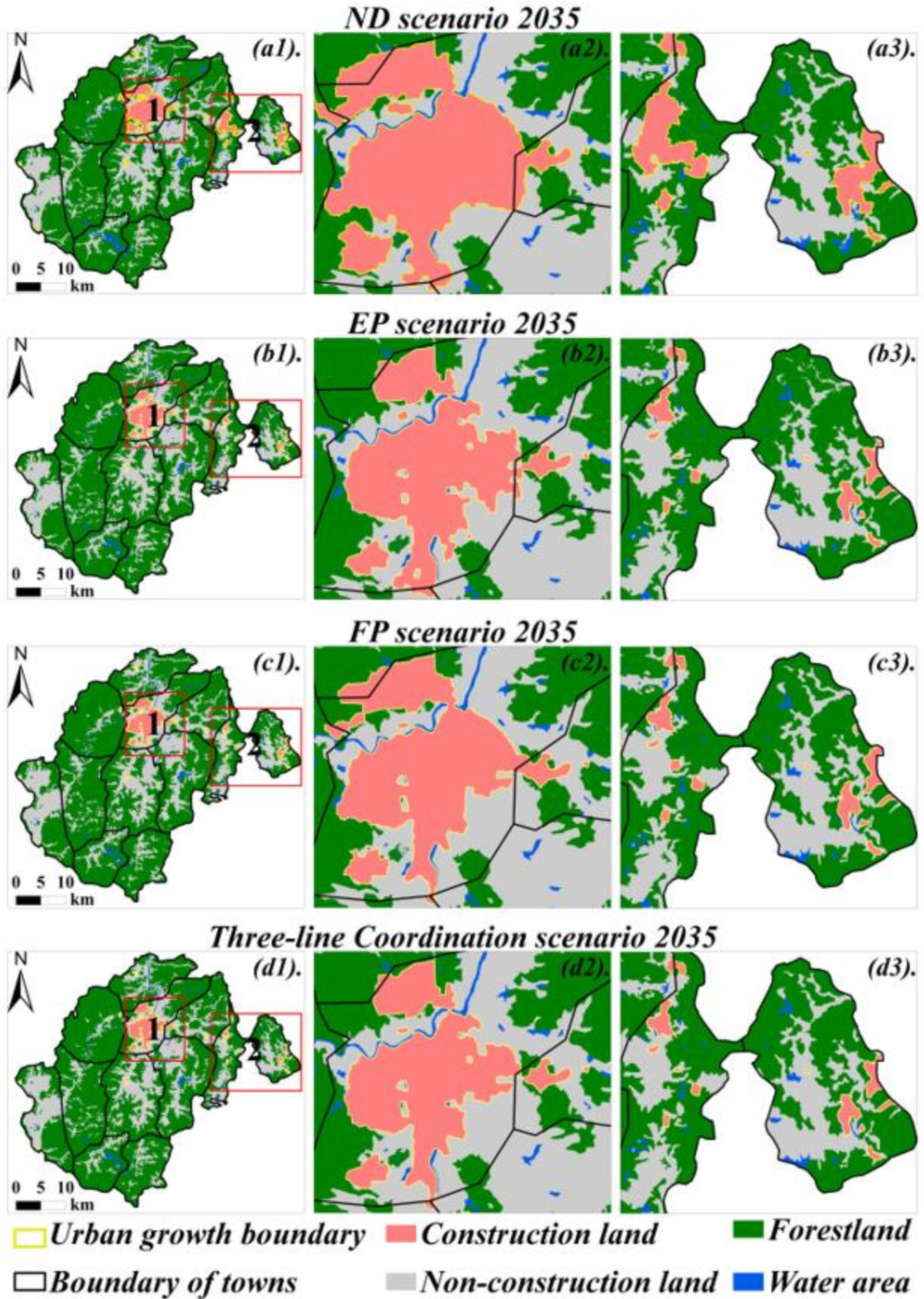
| Category | Data | Year | Data Resource |
|---|---|---|---|
| Land use | Land use data of Xinxing County | 2015 | Geographical information monitoring cloud platform (http://www.dsac.cn/dataproduct/detail/200804) (accessed on 1 June 2022) |
| Land use data of Xinxing County | 2020 | ||
| Statistical Yearbook | GDP | 2015–2020 | Statistics Bureau of Yunfu (https://www.yunfu.gov.cn/yftjj/gkmlpt/mindex#679) (accessed on 1 May 2022) |
| Fixed asset investment | 2015–2020 | ||
| Permanent population | 2015–2020 | ||
| Urban population | 2015–2020 | ||
| Grain production | 2015–2020 | ||
| Restricted area | Prime farmland protection area | 2020 | Natural resources bureau of Xinxing County (http://www.xining.gov.cn/yfxxzrzy/gkmlpt/index/) (accessed on 1 May 2022) |
| Ecological sensitive area | 2020 | Derived from spatial analysis of ArcGIS | |
| Driving factors | Distance to railway | 2020 | Open Street Map (http://www.openstreetmap.org/) (accessed on 1 March 2022) |
| Distance to main road | 2020 | ||
| Distance to highway | 2020 | ||
| Distance to water | 2020 | ||
| Distance to county government | 2018 | Baidu Map API (http://apistore.baidu.com/) (accessed on 1 March 2022) | |
| Distance to town government | 2018 | ||
| DEM | 2020 | Geospatial Data Cloud (http://www.gscloud.cn/) (accessed on 1 May 2022) | |
| Slope | 2020 | ||
| Aspect | 2020 | ||
| Industrial companies density | 2017 | Social Big Data Platform of East China Normal University (http://sdsp.ecnu.edu.cn/sdp) (accessed on 1 March 2022) | |
| Public facilities | 2017 | ||
| Economic development | 2019 | Earth Observation Group of NOAA (https://eogdata.mines.edu/products/vnl/) (accessed on 1 March 2022) | |
| Population density | 2019 | Huang et al. [39] |
| Scenarios | Scenarios Description | Simulation Constraints |
|---|---|---|
| Natural development (ND) | This scenario does not consider any policy constraints on land development. The development of future demand would follow the historical law of LULC change. Therefore, the results of this scenario can be used as a reference for the simulation results of other scenarios. | No constraint. |
| Farmland protection (FP) | Protecting the quantity and quality of prime farmland is crucial to maintaining regional food security. Thus, it is necessary to limit land conversion in the prime farmland area to prevent the rapid loss of prime farmland owing to uncontrolled urban expansion. | Taking prime farmland protection area as the restriction and prohibiting the farmland in this area from conversion. |
| Ecological protection (EP) | Ecological security is essential for the maintenance of biodiversity and regional environmental quality. Hence, the protection of ecological security pattern should receive attention. | Taking the ecologically sensitive areas as restricted area where the LULC within it is unable to be converted. |
| Farmland | Forestland | Grass Land | Water Area | Urban Land | Rural Area | Industrial Land | |
|---|---|---|---|---|---|---|---|
| Actual area | 329.78 | 1003.64 | 55.62 | 24.29 | 16.33 | 47.49 | 25.62 |
| Simulated area | 330.75 | 1004.89 | 55.21 | 23.48 | 15.77 | 46.15 | 25.98 |
| Relative error | 0.3% | 0.12% | 0.74% | 3.36% | 3.43% | 1.38% | 0.04% |
| Type | Markov | System Dynamics | ||
|---|---|---|---|---|
| ND Scenario | FP Scenario | EP Scenario | ||
| 2020 | 2035 | 2035 | 2035 | |
| Farmland | 329.79 | 307.36 | 326.16 | 320.01 |
| Forestland | 1003.64 | 991.57 | 999.26 | 1004.89 |
| Grassland | 55.62 | 57.09 | 53.52 | 54.41 |
| Water area | 24.29 | 25.08 | 24.76 | 24.76 |
| Urban land | 16.33 | 27.52 | 23.72 | 23.72 |
| Rural area | 47.49 | 48.1 | 45.52 | 45.15 |
| Industrial land | 25.62 | 46.06 | 29.84 | 29.84 |
Publisher’s Note: MDPI stays neutral with regard to jurisdictional claims in published maps and institutional affiliations. |
© 2022 by the authors. Licensee MDPI, Basel, Switzerland. This article is an open access article distributed under the terms and conditions of the Creative Commons Attribution (CC BY) license (https://creativecommons.org/licenses/by/4.0/).
Share and Cite
Lai, Z.; Chen, C.; Chen, J.; Wu, Z.; Wang, F.; Li, S. Multi-Scenario Simulation of Land-Use Change and Delineation of Urban Growth Boundaries in County Area: A Case Study of Xinxing County, Guangdong Province. Land 2022, 11, 1598. https://doi.org/10.3390/land11091598
Lai Z, Chen C, Chen J, Wu Z, Wang F, Li S. Multi-Scenario Simulation of Land-Use Change and Delineation of Urban Growth Boundaries in County Area: A Case Study of Xinxing County, Guangdong Province. Land. 2022; 11(9):1598. https://doi.org/10.3390/land11091598
Chicago/Turabian StyleLai, Zhipeng, Chengjing Chen, Jianguo Chen, Zhuo Wu, Fang Wang, and Shaoying Li. 2022. "Multi-Scenario Simulation of Land-Use Change and Delineation of Urban Growth Boundaries in County Area: A Case Study of Xinxing County, Guangdong Province" Land 11, no. 9: 1598. https://doi.org/10.3390/land11091598
APA StyleLai, Z., Chen, C., Chen, J., Wu, Z., Wang, F., & Li, S. (2022). Multi-Scenario Simulation of Land-Use Change and Delineation of Urban Growth Boundaries in County Area: A Case Study of Xinxing County, Guangdong Province. Land, 11(9), 1598. https://doi.org/10.3390/land11091598








